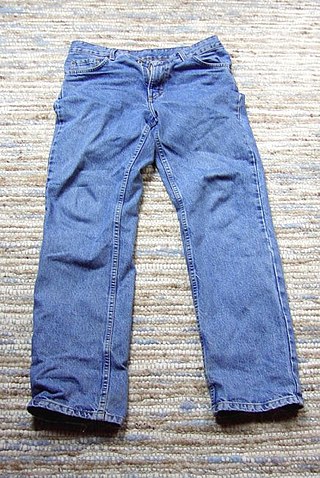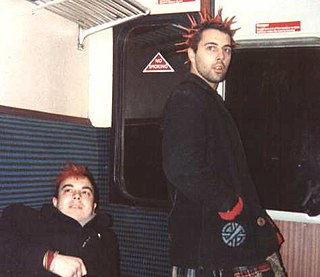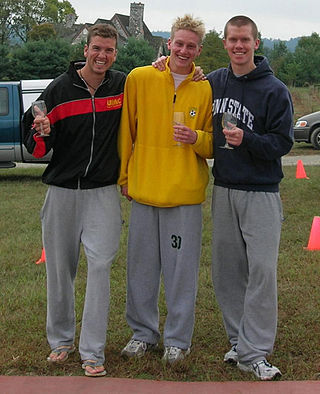Related Research Articles

Fashion is a term used interchangeably to describe the creation of clothing, footwear, accessories, cosmetics, and jewellery of different cultural aesthetics and their mix and match into outfits that depict distinctive ways of dressing as signifiers of social status, self-expression, and group belonging. As a multifaceted term, fashion describes an industry, styles, aesthetics, and trends.

Jeans are a type of pants or trousers made from denim or dungaree cloth. Often the term "jeans" refers to a particular style of trousers, called "blue jeans", with the addition of copper pocket rivets added by Jacob W. Davis in 1871 and patented by Davis and Levi Strauss on May 20, 1873. Prior to the patent, the term "blue jeans" had been long in use for various garments, constructed from blue-colored denim.

Punk fashion is the clothing, hairstyles, cosmetics, jewellery, and body modifications of the punk counterculture. Punk fashion varies widely, ranging from Vivienne Westwood designs to styles modeled on bands like The Exploited to the dressed-down look of North American hardcore. The distinct social dress of other subcultures and art movements, including glam rock, skinheads, greasers, and mods have influenced punk fashion. Punk fashion has likewise influenced the styles of these groups, as well as those of popular culture. Many punks use clothing as a way of making a statement.

A T-shirt is a style of fabric shirt named after the T shape of its body and sleeves. Traditionally, it has short sleeves and a round neckline, known as a crew neck, which lacks a collar. T-shirts are generally made of stretchy, light, and inexpensive fabric and are easy to clean. The T-shirt evolved from undergarments used in the 19th century and, in the mid-20th century, transitioned from undergarments to general-use casual clothing.

Heavy metal fashion is the style of dress, body modification, make-up, hairstyle, and so on, taken on by fans of heavy metal, or, as they are often called, metalheads or headbangers. While the style has changed from the 1970s to the 2020s, certain key elements have remained constant, such as black clothes, long hair and leather jackets. In the 1980s, some bands began wearing spandex. Other attire includes denim or leather vests or jackets with band patches and logos, t-shirts with band names, and spiked wristbands.

Bondage pants or bondage trousers are trousers with zippers, straps, chains, rings and buckles, giving an appearance of a BDSM style. They come in a variety of colors and patterns; one of the most common patterns being tartan. Bondage pants also come in a variety of styles, including tight or baggy, long, short or Capri.

The hanbok is a traditional clothing of the Korean people. The term hanbok is primarily used by South Koreans; North Koreans refer to the clothes as chosŏn-ot. The clothes are also worn in the Korean diaspora, especially by Koreans in China.

Fashion in the 1990s was defined by a return to minimalist fashion, in contrast to the more elaborate and flashy trends of the 1980s. One notable shift was the mainstream adoption of tattoos, body piercings aside from ear piercing and, to a much lesser extent, other forms of body modification such as branding.
Japanese street fashion refers to a number of styles of contemporary modern clothing in Japan. Created from a mix of both local and foreign fashion brands, Japanese street fashions tend to have their own distinctive style, with some considered to be extreme and imaginations, with similarities to the haute couture styles seen on European catwalks.

Fashion of the 1980s was characterized by a rejection of 1970s fashion. Punk fashion began as a reaction against both the hippie movement of the past decades and the materialist values of the current decade. The first half of the decade was relatively tame in comparison to the second half, which was when apparel became very bright and vivid in appearance.

The fashion of the 2000's is often described as a global mash up, where trends saw the fusion of vintage styles, global and ethnic clothing, as well as the fashions of numerous music-based subcultures. Hip-hop fashion generally was the most popular among young people of both sexes, followed by the retro inspired indie look later in the decade.

Fashion in the 1970s was about individuality. In the early 1970s, Vogue proclaimed "There are no rules in the fashion game now" due to overproduction flooding the market with cheap synthetic clothing. Common items included mini skirts, bell-bottoms popularized by hippies, vintage clothing from the 1950s and earlier, and the androgynous glam rock and disco styles that introduced platform shoes, bright colors, glitter, and satin.

Slim-fit pants or skinny jeans are tight trousers that have a snug fit through the legs and end in a small leg opening that can be anywhere from 9" to 20" in circumference, depending on size. Other names for this style include drainpipes, stovepipes, tight pants, cigarette pants, pencil pants, skinny pants, gas pipes, skinnies, and tight jeans.

Chinese clothing includes the traditional hanfu and garments of ethnic minorities, as well as modern variations of indigenous Chinese dresses. Chinese clothing has been shaped through its dynastic traditions, as well as through foreign influences. Chinese clothing showcases the traditional fashion sensibilities of Chinese culture traditions and forms one of the major cultural facets of Chinese civilization.

A fashion boot is a boot worn for reasons of style or fashion. The term is usually applied to women's boots. Fashion boots come in a wide variety of styles, from ankle to thigh-length, and are used for casual, formal, and business attire. Although boots were a popular style of women's footwear in the 19th century, they were not recognized as a high fashion item until the 1960s. They became widely popular in the 1970s and have remained a staple of women's winter wardrobes since then.

The 2010s were defined by hipster fashion, athleisure, a revival of austerity-era period pieces and alternative fashions, swag-inspired outfits, 1980s-style neon streetwear, and unisex 1990s-style elements influenced by grunge and skater fashions. The later years of the decade witnessed the growing importance in the western world of social media influencers paid to promote fast fashion brands on Pinterest and Instagram.

Slouch socks, slouchy socks,loose socks or fall down socks are a type of sock featuring a heavy non-elastic upper that may be pushed down into heavy folds around the ankles or pulled up to the knee. In Japan, the loose sock style has been popular with high-school girls. In the US, slouch socks have trended in and out of fashion since the 1980s.

Sweatpants are a casual variety of soft trousers intended for comfort or athletic purposes, although they are now worn in many different situations. In the United Kingdom, Ireland, Australia, New Zealand, and South Africa they are known as tracksuit bottoms or trackies. In Australia and New Zealand, they are also commonly known as trackpants, tracky daks or joggers. They are also referred to as jogging pants in Canada.

The keffiyeh or kufiyyeh, also known in Arabic as a ghutrah (غُترَة), shemagh, or ḥaṭṭah (حَطَّة), is a traditional headdress worn by men from parts of the Middle East. It is fashioned from a square scarf, and is usually made of cotton. The keffiyeh is commonly found in arid regions, as it provides protection from sunburn, dust, and sand. An agal is often used by Arabs to keep it in place.

The fashions of the 2020s represent a departure from 2010s fashion and feature a nostalgia for older aesthetics. They have been largely inspired by styles of the late 1990s to mid-2000s, 1980s, and late 1960s to early 1970s Early in the decade, several publications noted the shortened trend and nostalgia cycle in 2020s fashion. Fashion was also shaped by the COVID-19 pandemic, which had a major impact on the fashion industry, and led to shifting retail and consumer trends.
References
- 1 2 3 4 Birnbach, Lisa (1980). The official preppy handbook. New York: Workman Publishing. p. 193. ISBN 9780894801402. OCLC 6762701 . Retrieved 2 November 2023.
- ↑ Glenn, Joshua; Kingwell, Mark (29 September 2021). The Adventurer's Glossary. McGill-Queen's Press – MQUP. ISBN 9780228009481. OCLC 1246250152. Archived from the original on 1 November 2023. Retrieved 1 November 2023.
- ↑ Shapira, J.A. (17 August 2015). "Go To Hell Pants: A Game of Sartorial Chicken". Gentleman's Gazette. Archived from the original on 1 November 2023. Retrieved 1 November 2023.
- ↑ Hyland, Véronique (28 June 2021). "The Impolite Return of "Go-To-Hell Pants"". Elle. Archived from the original on 10 August 2022. Retrieved 1 November 2023.